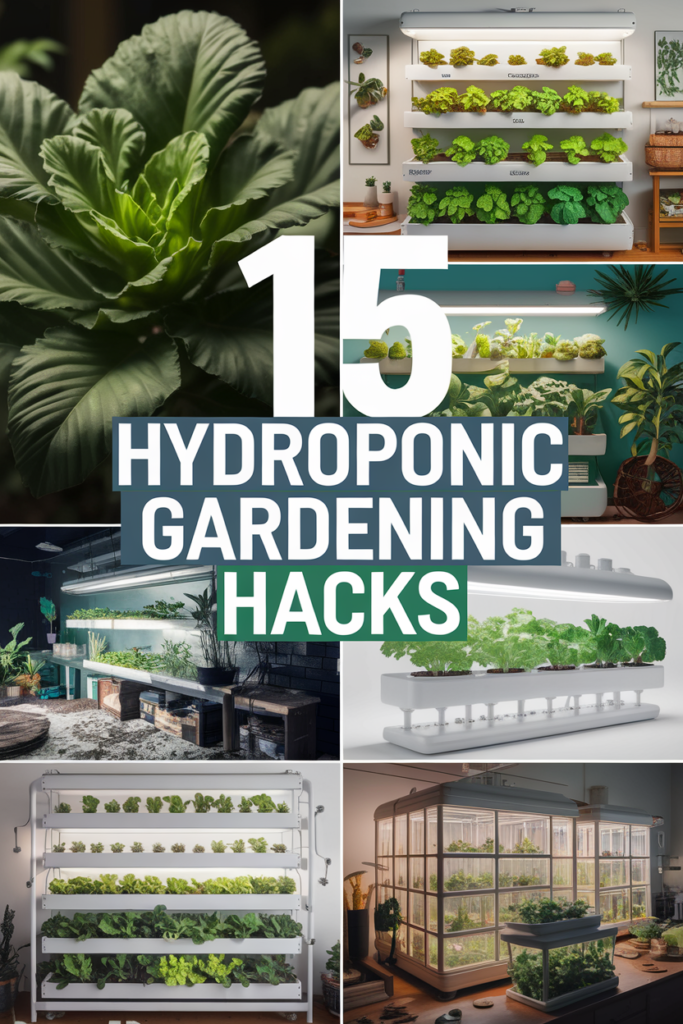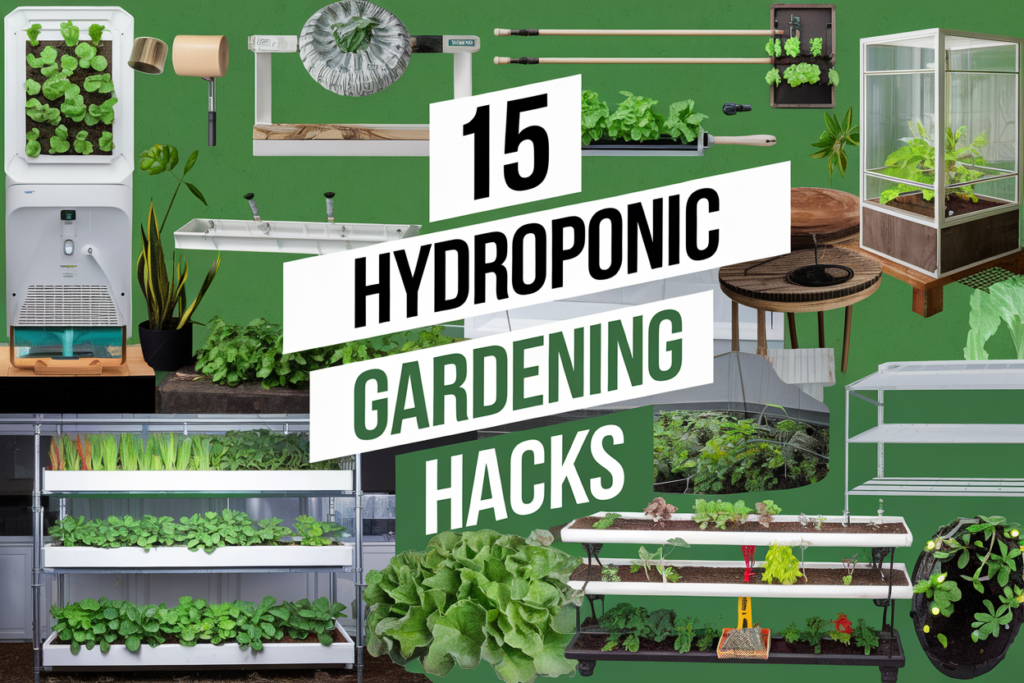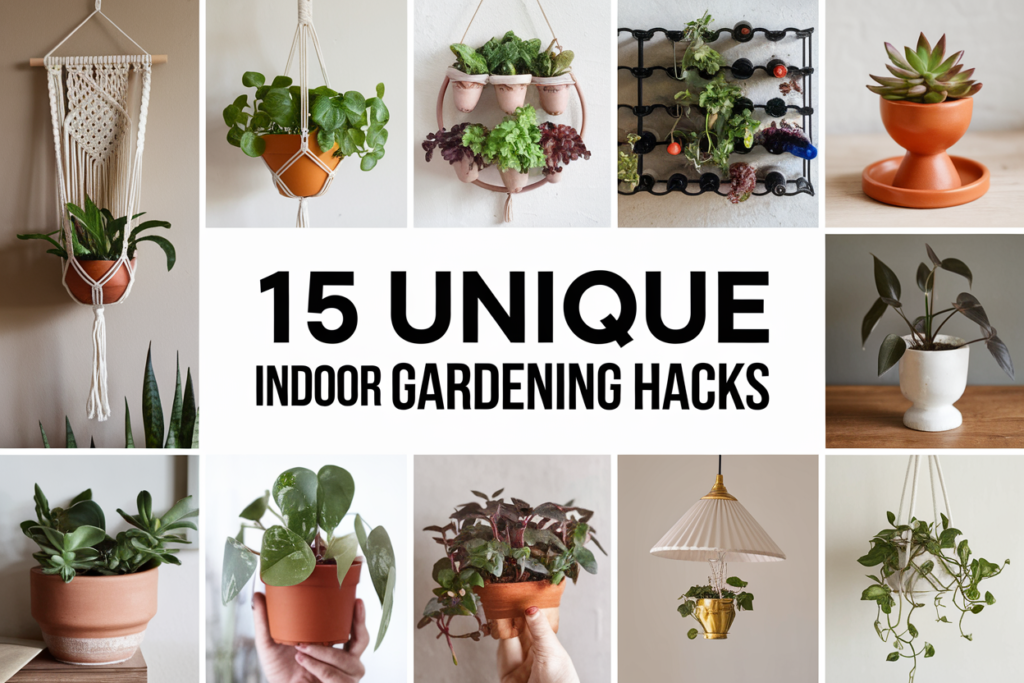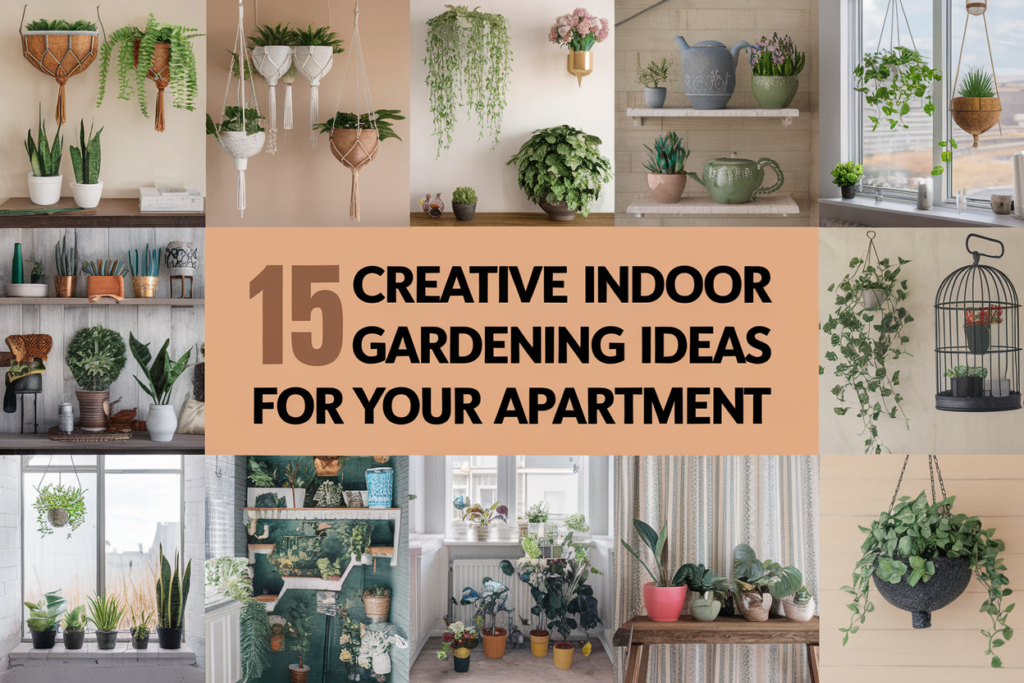Hydroponic gardening is all about creativity and efficiency. If you’re looking to give your plants a boost without breaking the bank, check out these 15 unique hacks that will help you maximize growth and yield. From simple tweaks to your setup to clever repurposing ideas, these tips are designed to make your hydroponic experience smoother and more productive.
Use An Aquarium Pump For Aeration In Diy Hydroponic Systems.
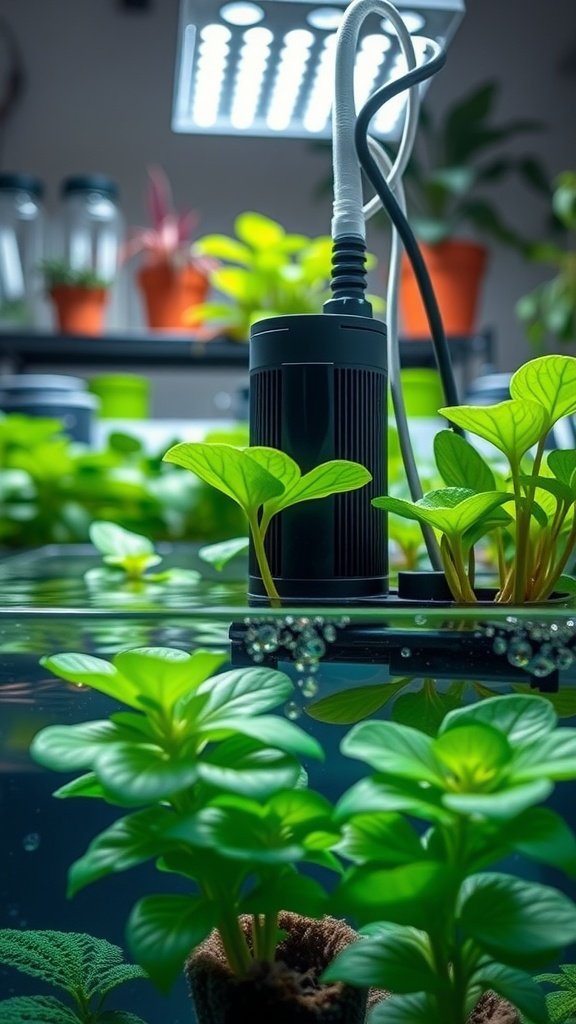
Using an aquarium pump is a brilliant way to improve aeration in your DIY hydroponic systems. In the image, you can see a pump working alongside lush, green plants thriving in a water-based environment. This setup highlights the beauty of hydroponics, where plants grow their best without soil.
The aquarium pump helps circulate oxygen throughout the water, making it accessible for the roots. Proper aeration is key to healthy plant growth. Without it, the roots can become waterlogged and unhealthy.
Setting up an aquarium pump is pretty straightforward. Just place the pump in your water reservoir and connect airstones or tubes to distribute the air. This simple hack can significantly boost the growth of your plants, leading to a more bountiful harvest.
Recycle Old Plastic Bottles To Make Simple Hydroponic Planters.
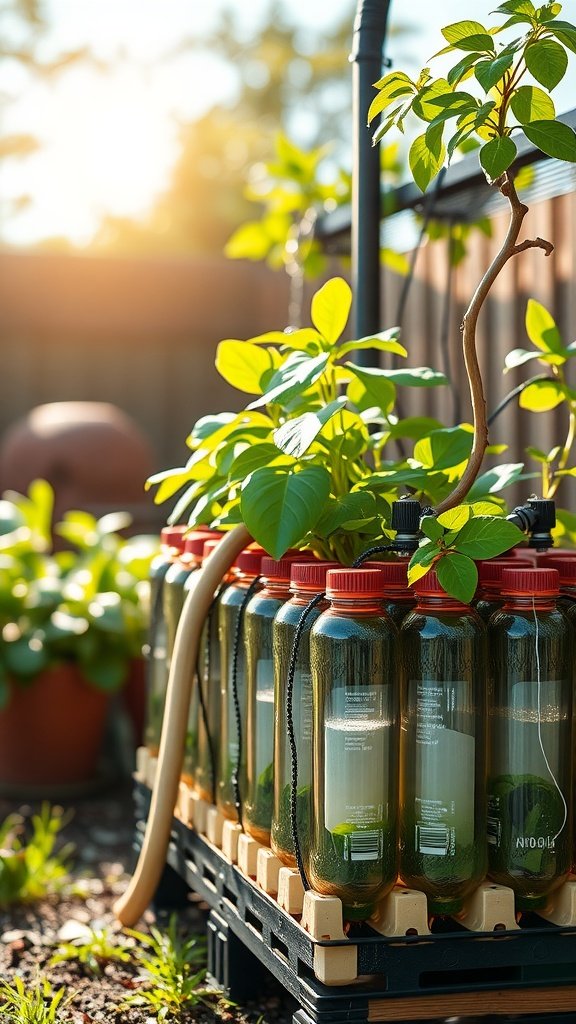
Using old plastic bottles as hydroponic planters is a fantastic way to recycle and grow your plants. In the image, you can see a neat setup of plastic bottles arranged in a row, each supporting vibrant green plants. The bottles are cut and filled with a nutrient solution, allowing the plants to anchor their roots while absorbing essential nutrients.
To create your own hydroponic planters, start by cleaning out the bottles. Cut them in half, keeping the top part to hold the plant. Drill a small hole near the bottom for drainage. Fill the bottom section with a growing medium like clay pellets, and insert the top part upside down. This creates a mini reservoir for your plants. Don’t forget to add water mixed with nutrients!
This method is cost-effective and makes gardening accessible, even in small spaces. Plus, it keeps plastic waste out of landfills. Check out the sunlight shining in the background; it highlights how important light is for the plants. A little creativity can turn your kitchen waste into a thriving garden!
Add A Ph Stabilizer To Prevent Fluctuations In Water Quality.
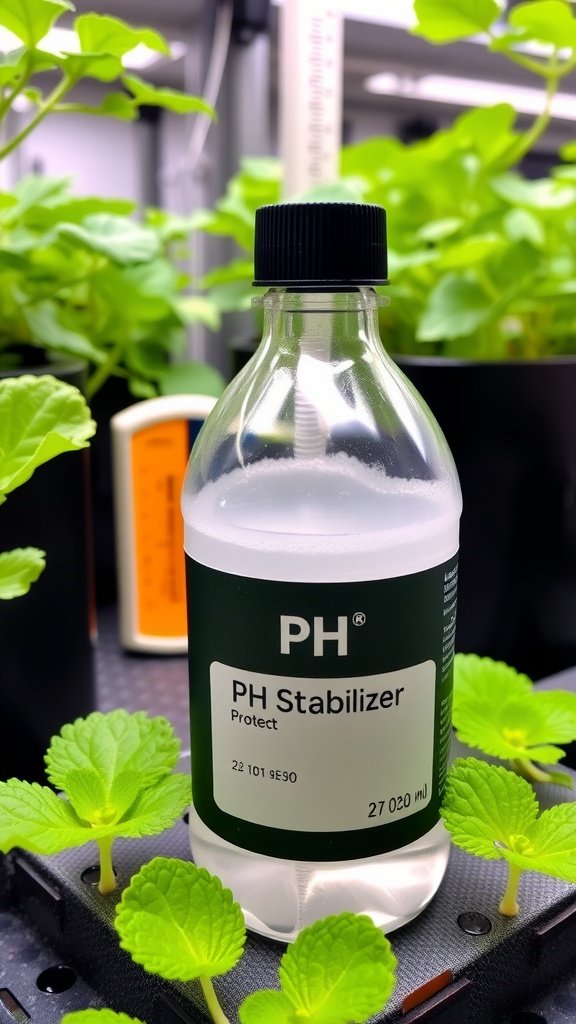
In hydroponic gardening, maintaining stable water quality is key to your plants’ health. This image highlights a pH stabilizer, a crucial tool that helps keep the pH levels consistent. Fluctuations in pH can stress plants, affecting their growth and overall yield.
The bottle on the table is clearly labeled, making it easy to identify. Nearby, you can see some vibrant green plants thriving under controlled conditions. This setup emphasizes the importance of using a pH stabilizer in your hydroponic system.
If you want to boost your growth, consider adding a pH stabilizer to your water. It creates a more predictable environment for your plants, allowing them to absorb nutrients more effectively. With the right tools, your hydroponic garden can flourish like never before!
Grow Plants In A Vertical Tower To Save Space And Maximize Yield.

Vertical gardening is a fantastic way to save space while growing a variety of plants. The image shows a sleek, multi-tiered tower filled with lush greenery, demonstrating how you can fit a lot of plants into a small area. This approach not only saves room but also maximizes sunlight exposure for each plant.
Using a vertical tower, you can grow herbs, strawberries, and even leafy greens. Each level allows for different types of plants, making it easy to create a diverse indoor garden. This setup is perfect for apartments or homes with limited outdoor space.
Moreover, vertical gardening can promote better air circulation and reduce the chances of pests, which is a bonus for plant health. Keep the tower near a window to ensure your plants get ample light. It’s an easy way to incorporate gardening into your life, no matter your space constraints!
Create A Diy Nutrient Film Technique (Nft) System With Pvc Pipes.
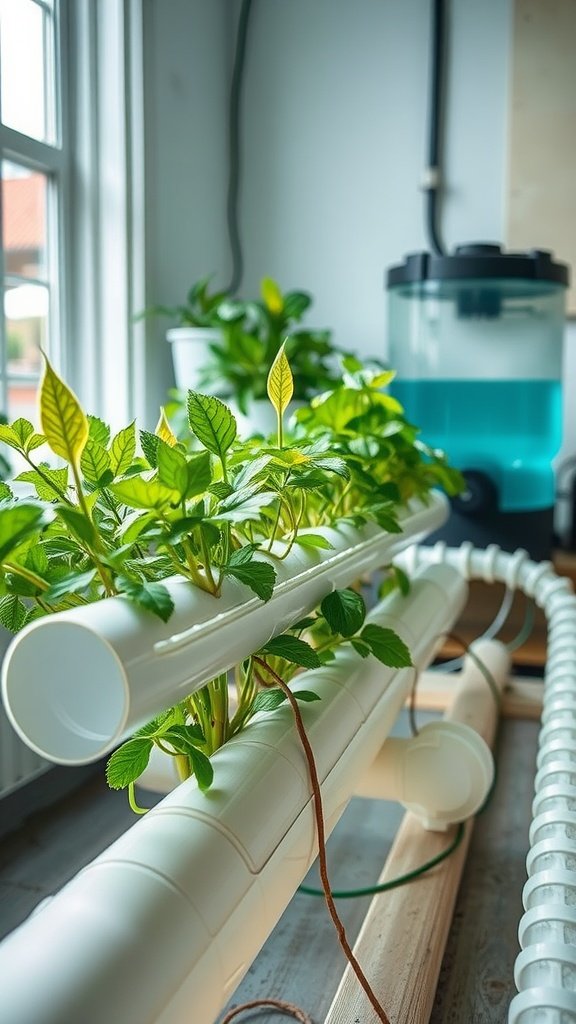
Building your own NFT system can be a fun and rewarding project. The image shows a simple setup using PVC pipes, where young plants are thriving. This method allows plants to get nutrients efficiently while minimizing water usage.
In the picture, you can see PVC pipes arranged horizontally. The plants are growing through holes made in the pipes, with their roots hanging down. Below, a reservoir holds nutrient-rich water, which is pumped into the pipes. This system creates a thin film of nutrients that flows past the roots.
Using PVC pipes is a great choice due to their affordability and durability. You can customize the length and arrangement to fit your space. As the water flows, plants get the essential nutrients they need for healthy growth. Plus, it’s low maintenance.
Setting this up can be done in a few easy steps. Gather your materials, including PVC pipes, a pump, and a reservoir. Cut holes in the pipes for your plants, connect everything, and watch your garden thrive!
Use A Fish Tank For Aquaponics, Combining Fish And Plant Growth.

Setting up a fish tank for aquaponics can be a delightful way to grow plants and keep fish. This symbiotic system works by utilizing the waste produced by the fish as nutrients for the plants. In return, the plants help filter the water, creating a clean environment for the fish.
The image shows a vibrant fish tank filled with lush green plants and lively fish swimming around. You can see the plants thriving, growing tall and green above the water, while the colorful fish add a lively touch. This setup not only looks beautiful but also creates a mini-ecosystem right in your home.
To get started, choose a suitable fish tank and select fish that fit your environment. Common options include goldfish or tilapia for beginners. Then, plant herbs or leafy greens like lettuce and basil in the grow beds. Make sure to monitor the water quality, light, and temperature regularly to keep both the fish and plants happy.
This combination of fish and plants is not just efficient; it’s also a fun way to engage with nature. Watching the fish swim and the plants grow can be a rewarding experience. So, grab a fish tank and start your aquaponics journey!
Keep A Backup Water Reservoir To Prevent System Dry-Outs.
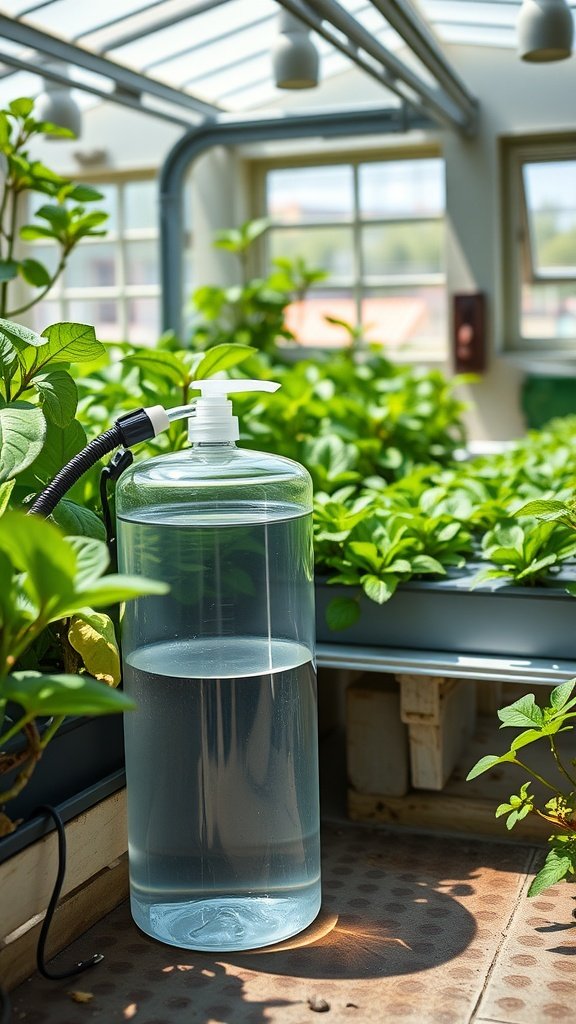
Having a backup water reservoir is a smart move for any hydroponic gardener. The image shows a clear container filled with water, sitting among lush green plants in a well-lit space. This setup highlights the importance of ready access to water, which is key for plant health.
When you’re growing plants hydroponically, they rely heavily on a consistent water supply. If your system runs dry, it can stress your plants and stunt their growth. By keeping an additional water reservoir nearby, you can easily refill your system whenever needed. It’s like a safety net for your plants!
Consider using a container that’s large enough to hold a good amount of water. This way, you won’t have to refill it too often. You’ll also want to place it in a spot that’s easy to reach, ensuring you can maintain your system without hassle. Having this backup means you’ll always be prepared, and your plants will thrive.
Use Coconut Coir As A Sustainable, Water-Retaining Growing Medium.
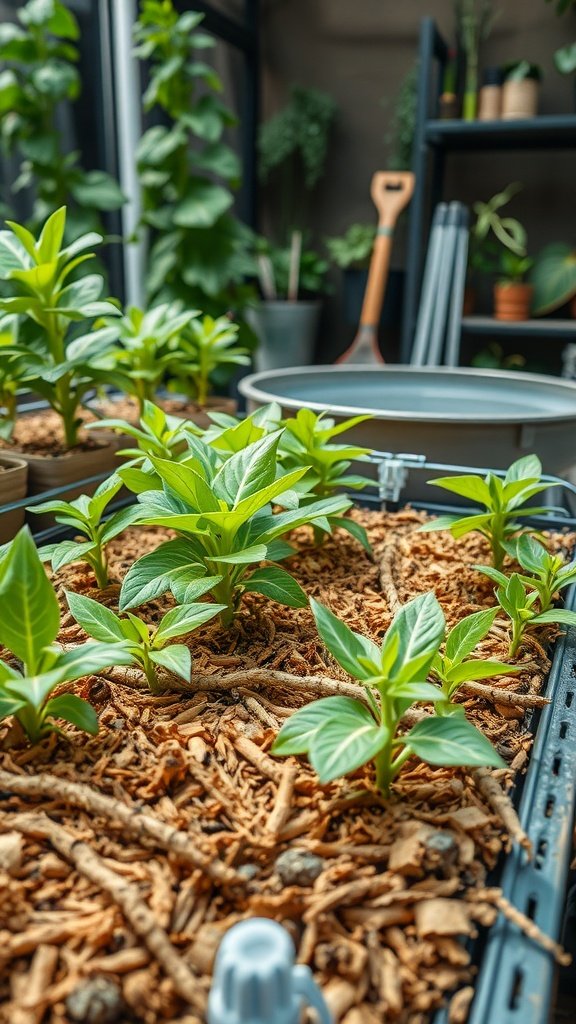
Coconut coir is a fantastic choice for hydroponic gardening. It’s made from the husks of coconuts, making it a renewable resource. This natural medium is not only eco-friendly but also highly effective in retaining moisture.
In the image, you can see fresh green plants thriving in coconut coir. The rich texture and brown color of the coir create a cozy environment for roots to grow. This setup is perfect for nurturing young plants, ensuring they have the support they need while absorbing water efficiently.
Using coconut coir also helps with aeration. Its fibrous structure allows air to circulate around the roots, preventing them from becoming waterlogged. This balance of moisture and oxygen is key to healthy plant growth.
Switching to coconut coir can be a simple yet effective way to boost your hydroponic garden. It’s easy to find and use, plus it adds a sustainable touch to your gardening practices. So, if you’re looking to enhance your growth, consider making the switch!
Incorporate Led Grow Lights For Energy-Efficient Indoor Gardening.

Using LED grow lights is a game-changer for indoor hydroponic gardening. These lights provide the right spectrum for plant growth while using less energy than traditional bulbs. The image shows a vibrant indoor garden illuminated by several LED grow lights, which highlights healthy plants thriving under optimal lighting conditions.
One significant benefit of LED lights is their longevity. Unlike other types of grow lights, LEDs can last for years, reducing the need for frequent replacements. This means you can focus more on growing your plants and less on changing bulbs.
Another perk is their low heat output. This allows you to place them closer to your plants without the risk of overheating. You can see how the lights are positioned above the lush green foliage in the image, showcasing how effective they are at promoting growth.
Using LED grow lights can also help you save on your electricity bill. They are designed to be energy-efficient, which is great for both your wallet and the environment. Plus, they come in various sizes and styles, so you can easily find the perfect fit for your indoor garden setup.
Set Up A Timed Water Pump To Automate Watering Cycles.
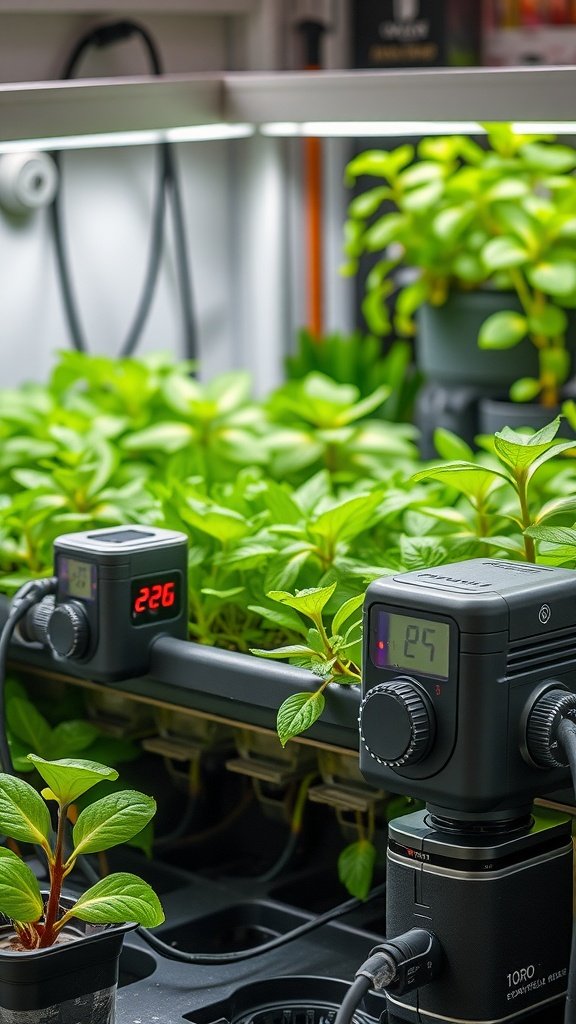
Automating your watering schedule can make a world of difference in your hydroponic garden. In the image, you see a setup featuring two digital water pumps. These devices help deliver the right amount of water to your plants at set intervals, ensuring they get what they need without overwatering.
The display on each pump shows specific settings—one is set at 226, and the other at 95. This indicates how you can customize the timing for each pump based on your plants’ requirements. The beauty of automation lies in its simplicity; once set up, you can focus on other gardening tasks without worrying about daily watering.
Using a timed water pump not only saves you time but also enhances plant health. Consistent moisture levels create an ideal environment for growth. Plus, you can adjust the schedule based on the season or plant type, making it a flexible option for any hydroponic setup.
Whether you’re a beginner or a seasoned hydroponic gardener, incorporating a timed water pump is a practical hack. It allows you to maintain your garden with ease and gives your plants the care they deserve.
Use A Ph Meter To Easily Track And Adjust Nutrient Levels.
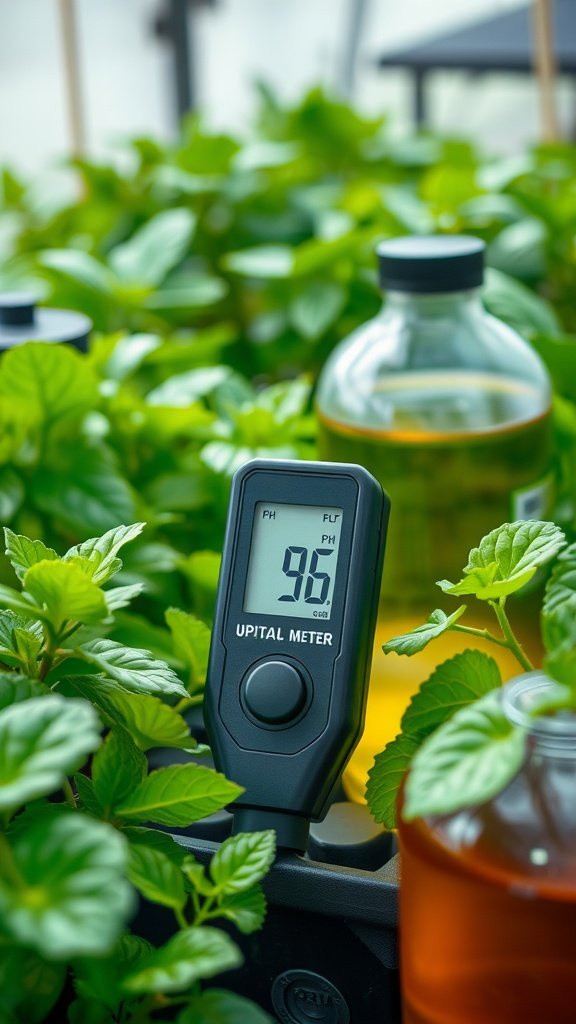
When it comes to hydroponic gardening, keeping an eye on pH levels is key to your plants’ success. The image above shows a handy pH meter nestled among vibrant greenery, ready to help you maintain the perfect nutrient balance. This little device can make a big difference in how your plants thrive.
Using a pH meter lets you accurately track the acidity or alkalinity of your nutrient solution. A pH level that’s too high or too low can lead to nutrient lockout, meaning your plants can’t absorb what they need to grow. By regularly checking the pH, you can avoid common pitfalls and ensure your plants are getting all the essential nutrients they crave.
Adjusting your nutrient solution based on the pH readings is straightforward. If your pH is off, you can easily add pH up or pH down solutions to get it back into the optimal range. This level of control is one of the many perks of hydroponic gardening.
So, don’t overlook the power of a pH meter in your garden setup. It’s a simple tool that makes it easy to keep your plants healthy and happy!
Grow Leafy Greens Like Lettuce Or Spinach In Net Pots For Faster Growth.

If you want to take your hydroponic gardening to the next level, growing leafy greens like lettuce or spinach in net pots is a fantastic choice. The image showcases vibrant green plants thriving in net pots, basking under bright LED lights. This setup creates an ideal environment for your greens to flourish.
Net pots are designed to allow roots to grow freely while ensuring excellent water and nutrient access. The mesh material lets air circulate, reducing the risk of root rot. This method is especially great for leafy greens that enjoy a cool, moist environment. You’ll notice how healthy and crisp the leaves can be when nurtured properly.
These pots are also quite easy to manage. Just fill them with your favorite growing medium, such as clay pellets or rockwool, and add seedlings. With the right light, water, and nutrients, you’ll see growth in no time!
Repurpose An Old Drawer As A Hydroponic Grow Bed For Small Plants.
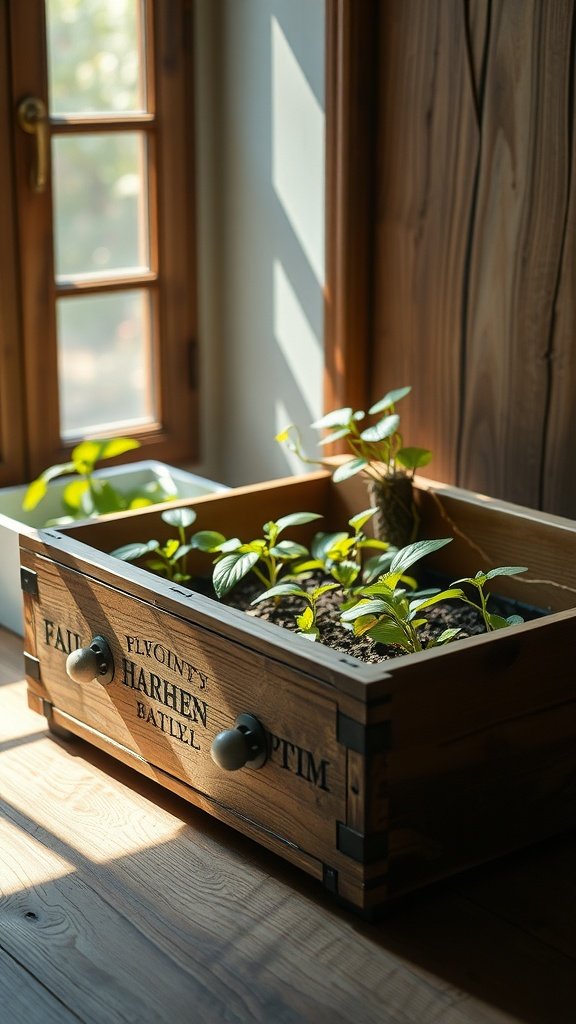
Using an old drawer as a hydroponic grow bed is an eco-friendly and creative way to grow small plants indoors. This simple hack not only saves space but also adds a charming rustic touch to your home. In the image, you can see a wooden drawer filled with healthy, vibrant plants basking in sunlight. The warm tones of the wood contrast beautifully with the bright green leaves.
To get started, grab an old drawer, ideally one with a good depth to hold the growing medium and water. Make sure to drill drainage holes at the bottom to prevent overwatering. Fill it with a suitable hydroponic medium, such as clay pellets or coconut coir, to help with water retention and root support.
Place the drawer near a sunny window where your plants can soak up natural light. This setup works great for herbs, small vegetables, or even flowers. It’s low-maintenance, and you can easily monitor the water level. Plus, it’s a fun project that showcases your creativity in hydroponic gardening!
Install A Water Chiller To Maintain Optimal Temperature For Plant Roots.
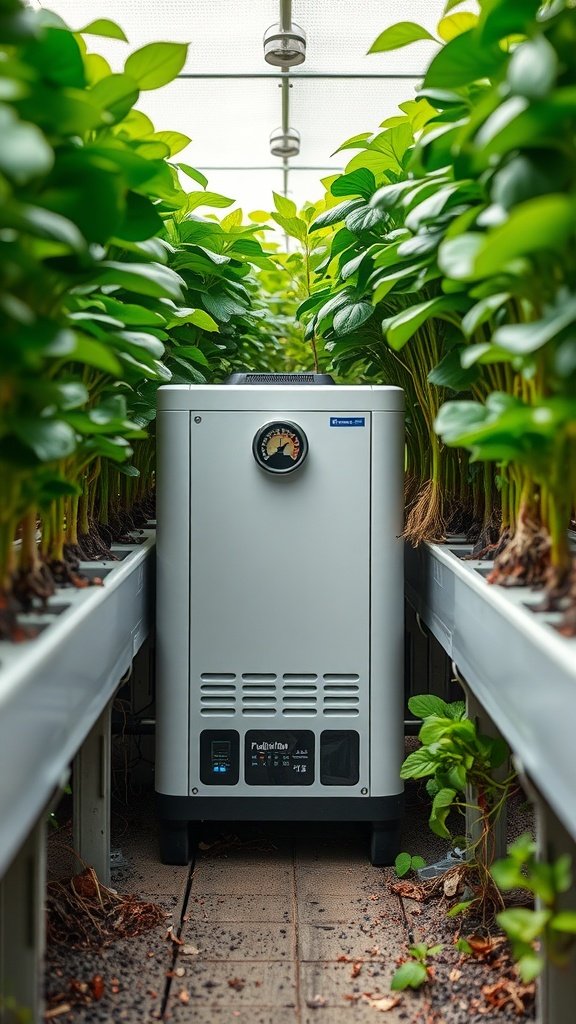
Keeping your hydroponic system cool is a game changer for plant health. The image shows a water chiller nestled between vibrant green plants, demonstrating how it can fit seamlessly into your setup. This piece of equipment is essential for controlling the water temperature, which is vital for root development.
Plants thrive in specific temperature ranges. Too warm, and roots can suffer from stress, leading to poor nutrient uptake. By installing a water chiller, you can maintain a consistent temperature, promoting healthy and robust growth. This setup not only supports your plants but also enhances the overall yield.
Imagine walking into your growing space and seeing lush, happy plants thanks to the perfect water temperature. A chiller can make that happen, giving you the peace of mind that your plants are getting the best care possible. Remember to check the specifications of your plants to find the ideal temperature range!
Create A Hydroponic Composting System To Add Organic Nutrients.
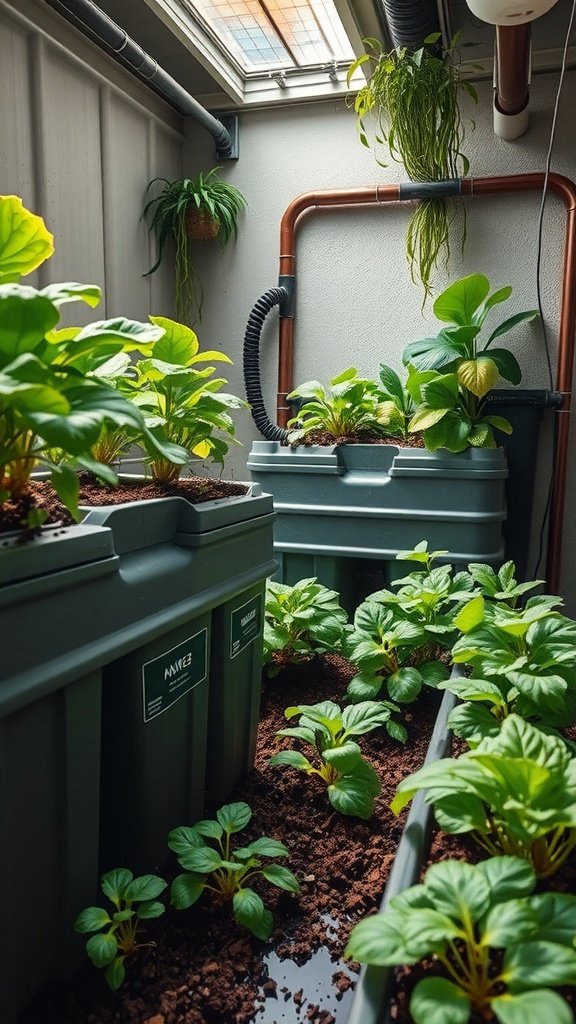
A hydroponic composting system can be a real boost for your plants. The image shows thriving greens in a well-organized space. Notice the containers filled with rich soil and lush plants basking in natural light. This setup highlights how you can merge composting with hydroponics.
Using organic nutrients from compost helps your plants grow healthier and stronger. By composting kitchen scraps and garden waste, you can create a nutrient-rich mix. This won’t just feed your plants; it will also improve root development and overall yield.
To create your own composting system, start by collecting organic materials like vegetable peels, coffee grounds, and eggshells. Layer these in your compost bins, mixing in some leaves or cardboard to balance nitrogen and carbon. Over time, you’ll have homemade compost ready to be added to your hydroponic setup.
Incorporating this practice not only enhances plant growth but also reduces waste. It creates a sustainable cycle that benefits both you and the environment. So, get your composting system started, and watch your plants flourish!
